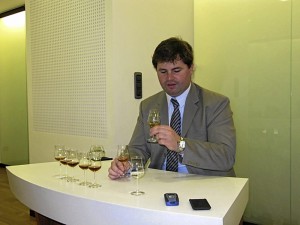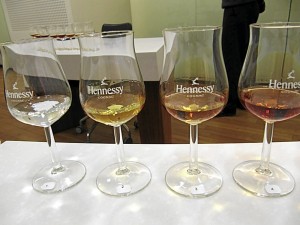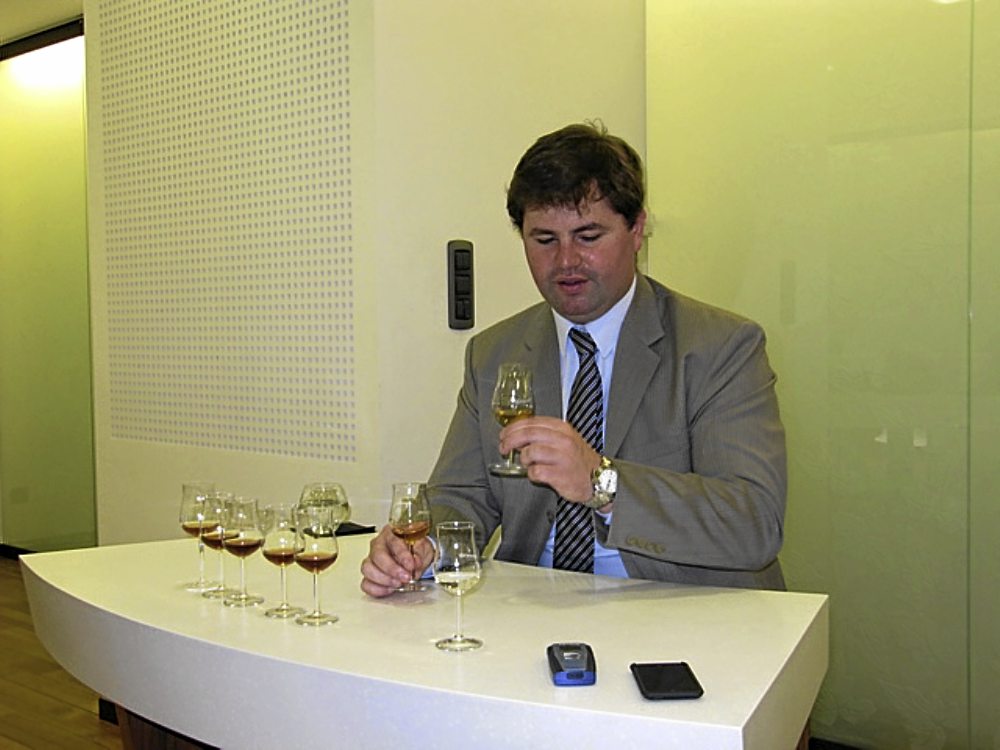
Being a member of Hennessy’s eight-man tasting committee is probably a job countless men would die for. But for Renaud de Gironde, a third-generation taster, his 10 years with the team has been a humbling experience, which also fostered in him patience, discipline and a keen taste for quality.
Since there are no schools for such disciplines, everything the economics graduate learned has been on the job. And he’s still learning, as the process is dynamic, highly subjective and never ending.
“After learning for 10 years, you’re allowed to speak a bit,” said Gironde, 34. “But before that, you can’t. You just keep quiet and try to learn as much as you can. Even now, nobody cares what I personally like. It’s about me knowing what is good for Hennessy.”
Since a great deal of Hennessy’s reputation depends on quality and consistency, the tasting committee’s responsibilities go beyond the present. The decisions and recommendations it makes today will determine the availability of the right stocks to blend in the future.
“Our goal is to provide a high-quality product with a consistent taste year after year,” he said. “In order to do that, we try to learn what’s best for Hennessy. You keep on learning until you absorb the Hennessy vocabulary by heart.”
Not an exact science
Making cognac is never an exact science. The key to obtaining a consistent taste is through proper blending. That’s easier said than done. The outcome is probably as unpredictable as the weather, because not all eau de vie taste the same as they mature.
The situation is made more complicated since the men have five Hennessy variants to consider: XO, VS, VSOP, Paradis and Paradis Imperial. Still, the committee persists by trying to come up with the right mix every time. Otherwise, some discerning customers are bound to notice glaring inconsistencies.
Led by Hennessy’s master blender, the committee gathers daily and, for almost two hours, taste, take notes and discuss the merits and demerits of everything—from fresh eau de vie purchased from growers to vintages the house has in stock. They also make recommendations whether a stock is to be used, transferred to another barrel or stored as it is.
“Hennessy isn’t just about one thing, but many things put together,” Gironde said. “At every stage of the process, we base our decision on one thing, which is quality.”
Apart from ensuring quality, tasting regularly keeps them up to speed with what Hennessy has in storage. This will play an important role in the company’s future decisions in supplying markets and allocating its prized cognac.
“Every year, we have to produce the same products using slightly different ingredients,” he explains. “We have to keep on adapting to a new recipe to ensure consistent results. And to do this, you have to have extensive knowledge of your stock.”
Extensive blending
And when the committee talks about blends, they’re not limited to two or three elements. Sometimes, they go through and recommend combining as many as 50-100 samples to create the desired cognac.

In a separate session in Hennessy’s nearly all-white tasting classroom, Gironde went on to illustrate the process in detail through the use of small glasses containing eight different samples—from crystal-clear eau de vie to the top-of-the-line Hennessy Paradis Imperial. Each participant also had the same set of samples in front of him.
Sniffing could give you a vague idea of how an eau de vie has developed. But only by tasting a sample (not swallowing, as you normally have 40 more samples to try) can one truly know and experience cognac’s true potentials.
“Glass number six contains Hennessy XO, which we’ve been offering for 104 years now,” said Gironde. “It’s a dark cognac because all eau de vie that make up the XO have spent some time in new barrels. It also has an intense creamy taste.”
In contrast, glass number seven contained Paradis, which Gironde described as “more central, even more feminine” than the other variants.
“There’s only one problem when you open a bottle of Hennessy Paradis,” he said in jest, “everybody would want a second, even third drink. It’s so effortless, so easy to understand and enjoy. It’s like a partner taking your hand and leading you to the dance. You just go with the flow and enjoy.”
Then, finally, there’s the top-of-the-line Paradis Imperial served in an unnumbered glass.
Its origin dates back to the time of the Russian czars in the early 19th century. According to Hennessy’s archives, the then Empress Maria Feodorovna commissioned the house to do a cognac to mark her son Czar Nicholas’ birthday. The result later became the inspiration behind Paradis Imperial.
“This is considered a drop of gold, the ultimate luxury,” said Gironde, referring to the pricey drink. “This blend is not our creation. It’s all my ancestors’ creation because it was them who did the hard part.”













































